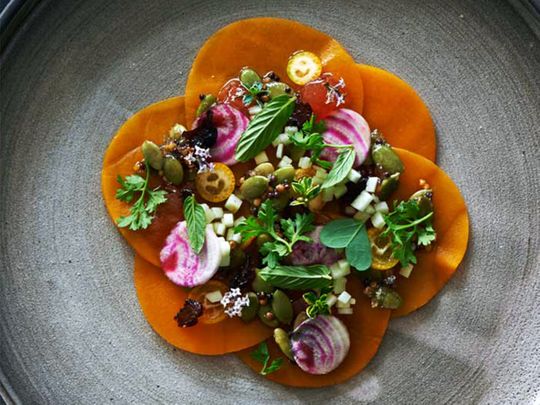Ingredients
1 pound butternut squash
1 tespextra-virgin olive oil
8 sprigs lemon thyme
1⁄2 tsp sea salt
1 cup quince, peeled and chopped
2 slices/shaves of lemon peel
1 vanilla pod, split 12 sprigs of lemon thyme, wrapped and tied in cheesecloth
1 cup cane sugar
1⁄2 cup brown mustard seeds, whole
1⁄2 cup yellow mustard seeds, whole
1⁄2 cup apple cider vinegar 1⁄2 cup agave
1⁄2 cup water, filtered
1 tbsp sea salt
1 1⁄4 cups pumpkin seeds
1⁄2 cup filtered water
1 cup organic cane sugar
1⁄2 cup maple syrup
1⁄2 tsp baking soda
2 tsp coconut oil, melted
1 pinch salt
1 pinch cayenne pepper
1 Granny Smith apple, peeled and diced
1⁄2 tsp lemon juice
1 pinch sea salt
2–3 kumquats, seeded and sliced
1 small Chioggia beet, thinly sliced on a mandoline
1⁄4 cup black cured olives
Herbs (chervil and mint recommended)
Oxalis
Coriander flowers
Flake salt
Method
Cut the squash right above the bulb where the seeds are stored and reserve the round bottom for another use (not used in this recipe). Peel the squash with a peeler and slice into rounds, using a very sharp mandoline slicer. Toss the squash with olive oil, thyme, and sea salt.
Arrange squash rounds into round flower shapes and place them in between parchment paper. Store them on a flat sheet pan in the refrigerator until ready to serve.
Place quince and the remaining ingredients, except the cane sugar, in a saucepan and fill with water, just enough to cover the ingredients. Bring to a boil and simmer for 25 minutes. Remove from heat and strain. Discard all ingredients except the quince and lemon peel.
In a high-speed blender, purée the quince and lemon. Place the cane sugar and quince purée in a saucepan and cook on low for 1 hour.
Mix all ingredients in a bowl. Let sit for about an hour to allow the mustard seeds to bloom. Remove half the mixture, blend in a high-speed blender, then pour the blended mixture back into the remaining mixture. Stir. Let the mixture sit out at room temperature for 1 to 2 days.
Toast the pumpkin seeds over medium heat in a pan, constantly moving the seeds around the pan so they do not burn. Remove from the heat as soon as they begin to brown around the edges.
Line a baking sheet with parchment paper. Attach a candy thermometer to the side of a medium saucepan. To en- sure an accurate temperature reading, make sure the candy thermometer does not touch the bottom of the pan. Heat the water, cane sugar, and maple syrup over medium high heat. Remember to stir constantly with a wooden spoon until the liquid starts to boil. Stop stirring, increase the heat slightly, and allow the mixture to boil until it reaches 140C.
At this point, add the pumpkin seeds to the saucepan and stir continuously, making sure the mixture does not stick to the bottom of the pan, until the temperature reaches 148C.
Remove from the heat and stir in the remaining ingredients. The baking soda will cause the mixture to bubble slightly. This is expected.
Working quickly before the liquid begins to harden, pour the mixture onto the parchment-lined baking sheet. Use the back of a wooden spoon to spread the batter evenly across the sheet. Allow the brittle to completely harden at room temperature, about 2 hours.
Break the cooled candied pepitas into shards and store in an airtight container at room temperature up to 1 week.
For the apple, combine it with the lemon juice and salt. Set aside.
Dehydrate at 68C in a dehydrator or an oven for 12 hours, or until completely dry. Transfer the dehydrated olives to a food processor and pulse a few times until they are roughly chopped.
Remove squash rounds from parchment paper and place on a large round plate. Spoon 51⁄4 tsp of quince purée on top of the carpaccio, followed by five 1⁄4 tsp of pickled mustard seeds.
Sprinkle 1 tbsp candied pepitas, 1 tbsp of diced apples, and 1⁄2 tbsp dehydrated olives on top. Place thinly sliced kumquats and beets on top. Garnish with chervil, mint, oxalis, coriander flowers, and flake salt. It's ready to be served.




